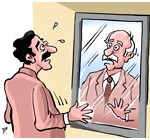Midlife Crisis? What Midlife Crisis?
 Recently, I have become fascinated with the notion of the midlife crisis because I sense that I am crossing over some invisible mark. The Merriam-Webster dictionary defines a crisis as an "emotionally significant event or a radical change of status in a person's life." While I do sense some radical change afoot on a subtle level, it doesn't have the sense of angst that the word "crisis" implies. It feels more like a "midlife evolution," which is "a process of gradual, peaceful, progressive change or development."
Recently, I have become fascinated with the notion of the midlife crisis because I sense that I am crossing over some invisible mark. The Merriam-Webster dictionary defines a crisis as an "emotionally significant event or a radical change of status in a person's life." While I do sense some radical change afoot on a subtle level, it doesn't have the sense of angst that the word "crisis" implies. It feels more like a "midlife evolution," which is "a process of gradual, peaceful, progressive change or development."
One way that I sense an evolution is that my wife, Melissa, and I are in a fascinating, new discussion about whether we will or will not have a child. When we first married three years ago, we were both adamant that kids were not for us. Neither of us felt the imperative that many of our friends did in their late 20s and early 30s to have a child. But, now, as we approach the middle of life, we can feel the stirrings of new life wanting to be created. Whether that means we will have children or we will create new things in the world is still to be seen. What's significant about this discussion is that it's not being driven by a need either to rebel against the system or acquiesce. Instead this inquiry is about searching deeply for our shared heartfelt desire. It's not about what's wanted (or, in the case of rebellion, not wanted ) "out there," but about what's wanted "in here."
Shifting from Outer Goals to Inner Purpose
For the first half of life, we all tend to take someone else's path. We develop a personality and identity that allows us to survive and succeed within relationships, family units, and society as a whole. I spent most of the first half of my life in school or learning various spiritual and healing practices in the East. Since my early thirties, I have been earning my chops in practice, as a yoga teacher, life coach, and acupuncturist.
But now, I sense that I am crossing over some invisible line. In a way, it's a line I have been aching to cross over. I finally am being recognized for my gifts and talents on a professional level. And while I am thrilled to finally start to have the impact I have been wanting to make for so many years, there's a part of me that wonders whether my work alone will completely satisfy me. In addition to my professional life growing in a positive direction, I also sense a deeper stirring within my spirit. I have always felt connected to spirituality, but now, more than ever, I feel called to connect to spirit.
Taking Stock at Midlife
Sometime in the middle of life, most of us wake up to the realization that in spite of the energy we've put into our careers, roles, and relationships, something else wants to find expression. For those who have already realized a dream, often times the question we ask, “Is this all I get? I thought that there would be more.” And when a person fails to realize the dream, it is a time to account for the never: “I suppose I will never be a millionaire or have children of my own.” Essentially it's a time to come to terms with the carrot we've all been chasing. But, in addition, we also feel called to something more. That something shows up in the form of a mystery or one big question mark.
When my clients are in the throes of "midlife evolution," we work to look deeper than the urges to quit a job, or leave a marriage or buy a Ferrari to uncover the deeper, heartfelt desires. I've worked with clients who are good husbands and fathers. They work hard, earn a good salary, and have provided a safe and beautiful home for his family. But while they love their children and wife, a part of them feels absolutely trapped by the conventions of marriage and family.
Midlife Choices: Self-Enlarging or Diminishing
People tend to take the urges that arise at this point, to find a secret lover or quit their jobs, at face value. The midlife evolution calls the meaning we have made of life into question. And when it does, we have a choice. That choice can be either enlarging or self-diminishing.
The second half of life is a very different one than the first half. And midlife is where the path shifts significantly. The maps that got us to where we are when we reach the middle of life no longer serve us the way they previously did. Previously, our orientation was towards outer world: goals, graduations, successes, wins. While this does not end in the middle of life, since most of us have household responsibilities that we need to tend to, we also notice that we are in a totally different period, a new form of adulthood.
Midlife as an Initiation into Mystery
And if we embrace this new form of adulthood, this second half of life, it has the possibility of enlarging self. Recently, I have been reading The Power of Myth, which is based on interviews that took place between the journalist, Bill Moyers, and the mythologist, Joseph Campbell, in the late-80s. Campbell essentially says that in the second half of life, our access to the deeper mysteries increases exponentially. The orientation of life in the first half is about forming the structures of success and survival. In the second half, it's more about the uncovering of the deeper meaning of life. In the second half of life, the doors of perception are cleansed, and we have access to this inquiry in a way that we hadn't in the first half.
It's my hunch that this is the deeper purpose behind the "midlife evolution." This period marks that transition. And the point is not to lead us back into adolescent strivings but to guide us into having access to the deeper mystery called life.
What's missing for all of us is the honoring of this transition. We have no ritual, no myth, nothing that recognizes this evolutionary leap we go through at this stage. Instead of saying that this is a time we get to deepen and become wiser, we tend to just want to cover our heads in the sheets and say, "I'm forty, and I feel old." While nothing dramatic like that has happened to me, I get hits of this. I was recently teaching a workshop for several 20-year-olds, and I was noticing that I was the only guy with gray hair there. Now, I don't mind my grays, but I just found it weird that I wasn't young anymore. It's subtle, but I am paying attention, and what I am noticing is that there really is no dialogue in our culture about this transition.
Learning from Midlife Crisis
Midlife crisis can be a big wake up call to those of us who are asleep. But what about those of us who strive to be awake? What about those of us who are watching this transition taking place and don't have a forum or a language that can help us meet, embrace, and learn from what's occurring? I am not sure I know what the answer is. I tried linking it back to the four stages of life described within Hindu culture, but this transition really isn't recognized. The same is true of Shakespeare's seven stages of life. It makes me wonder, whether this transition is a modern phenomena rather than a historical one.
In any event, it's my sense that those of us who strive to be awake are looking for a sort of honoring of this transition, and it starts with a dialogue, a dialogue that enters us into the deeper meaning of our lives and, ultimately, our purpose on this planet.




 The transformational shift that can occur around the sacred wound feels a whole lot like a descent. It has a downward quality to it. It often feels heavier, stickier, thicker, and more difficult before it ever starts to feel better. In 12-step programs, they often say that one has to hit 'rock-bottom' before any real change can take place. When we acknowledge the emotion around the wound in a deliberate, conscious way, we take ourselves to a 'rock-bottom' place.
We expect and seek to create a sort of descent. At the bottom of the descent is both an acknowledgement and acceptance of the wound. People often report a sigh of relief. What they recognize is that those aspects of the wound that they’ve disowned becomes included into who they are. There is a very clear sense of widening, deepening, and expanding at the moment in which the descent has completed itself.
The transformational shift that can occur around the sacred wound feels a whole lot like a descent. It has a downward quality to it. It often feels heavier, stickier, thicker, and more difficult before it ever starts to feel better. In 12-step programs, they often say that one has to hit 'rock-bottom' before any real change can take place. When we acknowledge the emotion around the wound in a deliberate, conscious way, we take ourselves to a 'rock-bottom' place.
We expect and seek to create a sort of descent. At the bottom of the descent is both an acknowledgement and acceptance of the wound. People often report a sigh of relief. What they recognize is that those aspects of the wound that they’ve disowned becomes included into who they are. There is a very clear sense of widening, deepening, and expanding at the moment in which the descent has completed itself.






